Of everything grown in the kitchen garden throughout the year, no harvest is more anticipated than that of our heirloom tomatoes. Each year, even when schedules and daily life are too hectic to plant anything else, we make time to plant tomatoes. A summer without garden fresh tomatoes, would be like a summer without sun.
Last summer was a very challenging season throughout much of California with cool coastal temperatures, and persistent fog lasting much later through the season than normal. Harvests were delayed by at least a few weeks for most varieties. Overall, despite a late harvest, yields were modest, but we hoped this season would prove to be a vast improvement.
At the start of the season we had plentiful, and promising rains, but our wet spring soon gave way to an unseasonably cold, dreary, and damp summer. By mid-summer, while the rest of the country was melting in record heat, our dense marine layer produced thick, unrelenting coastal fog, at much higher elevations than normal. This kept temperatures down, and increased humidity levels. Some days, in the height of summer, we never saw the sun.

Noon, at the end of August, the temperatures should be soaring...not 56F with 93% humidity...and no sun
This translated into yet another summer where the tomato harvest was substantially delayed relative to previous years. In fact, this is the first year that we’ve noticed a significant effect of the weather on actual fruit set, not just ripening. Overnight temperatures were consistently below 55F, and some varieties, even the cherry tomatoes, struggled to set any fruit for most of the season.
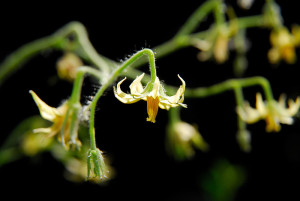
Some varieties, like Blondkopfchen, produced lots of flowers, but failed to set fruit in the cool weather
It wasn’t all bad. The first week of July we flirted with near 100 degree temperatures, around the time Jenny’s eggs hatched. Little did we know though, that would prove to be the warmest weather we’d have all summer. This is the first year since we’ve been at this location that we didn’t crack the century mark all season.
Despite the cool weather, the garden was looking promising by late July. Unfortunately, the burst of heat over 4th of July was followed by persistent cold and damp, and coupled with the earlier vole damage to some of the tomato plant stems, this resulted in something sinister developing in the tomato garden, and for the first time we started using the F-word. Fusarium. By August we were hit with Fusarium wilt, hard.
We’ve never been hit with wilt, either Fusarium wilt, or Verticulum wilt. Unfortunately, as our entire tomato crop this year was growing on heirloom vines, on native root stock, none of the varieties we were growing were resistant to either organism.
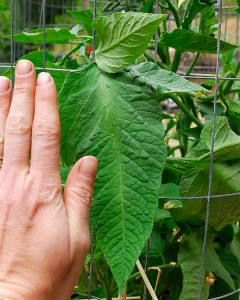
The plants, like this Stupice, were off to a healthy start early in the season...but by August Fusarium wilt was wreaking havoc in the garden
Although this area is perhaps more prone to Verticulum wilt, Race 1 Fusarium wilt isn’t uncommon in this region. Verticulum wilt can impact yields, but Fusarium wilt can kill entire plants, and that was certainly true for us this season. By late August most of the plants in the garden were showing at least some degree of infection.
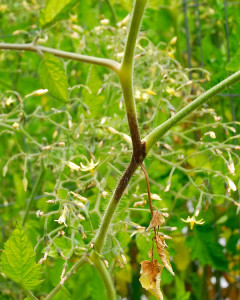
Early signs of wilt include yellowing of leaves on some of the stems. Dark brown discolored areas on the stem can quickly spread, and deprive any developing fruits of nutrients.
Some varieties, like Beam’s Yellow Pear, rapidly collapsed and died, long before there was any hope of fruit ripening.
It’s proven to be a very humbling experience this summer. It’s true, there really is a first time for everything. Last season was less than ideal for tomatoes, but this season, for the first time ever, our tomato crop was a near total failure.
Not all of the varieties we grew were a complete loss. A few showed some promise in regards to being somewhat resistant to infection, including Salisaw Cafe, Argentina, German Red Strawberry, and an orange sport of German Red Strawberry that we propagated from our own seed this spring. None of the plants thrived though, and those that did struggle to set fruit, and not succumb before the fruits were ripe, yielded far fewer fruits that were significantly smaller than normal. This is how the season shaped up for the varieties we planted this season:
Argentina – fruits were smaller this year, but the plants seemed relatively resistant to wilt, although not as resistant as our oxhearts. Set a modest amount of fruit, but struggled to ripen before season’s end.
Azoychka – poor yields, but we did enjoy a few modestly sweet, low-acid, yellow fruits before the plants succumbed. Certainly showed promise, and we’d plant again.
Beam’s Yellow Pear – Our best performing cherry tomato last year, that refused to stop setting fruit, even after the first frost, this year was a complete and total loss, and the first variety to completely succumb to wilt this season. We’ve had tremendous success with this variety previously, so it will remain on our list of varities to plant again.
Black Cherry – Despite damage to the vines from both wilt and voles, this variety did still manage to produce a fair crop of 1″ sweet fruits. More in fact than either of the other two cherry tomato varieties planted this year (Salisaw Cafe, and Blondkopfchen). In a normal year, in the absence of wilt, with sufficient sunshine, we’d expect this variety to do very well here. Like many black tomatoes, these fruits were sweet, with a complex, slightly smoky, tomato flavor. Certainly worth trying again.
Black Pear – Excellent performance the last two years in our gardens, and one of our highest yielding, and most flavorful tomato varieties. This year yields were down significantly, but overall production was still the highest of any of the mid-sized tomato varieties in the garden this season. The plants looked horrendous by late September, and did eventually succumb to Fusarium wilt. Overall though this variety still performed beyond our expectations, at least in the early season, and the fruits ripened before most others, including our cherry tomatoes!
Blondkopfchen – we planted this variety as an heirloom replacement for Sun Gold this year. Unfortunately, Blondkopfchen seemed the most set back of all the cherry tomatoes by our cool overnight temperatures. It produced a staggering number of flowers early in the season, but simply failed to set fruit until the end of August. By this time, the plant was winding down for the season, and overall yields were abysmal. Fruits weren’t particularly sweet, and the skins unpleasantly tough (likely secondary to overall vine damage).
Crnkovic Yugoslavian – Flavor was good, but production very low. The plants struggled to set any fruit, producing only a few per plant, and most didn’t ripen before summer’s end.
Federle – the fruits of this paste tomato were significantly larger than San Marzano this year, but the total yield less than half. A very meaty tomato, with good flavor, and few seeds, it has virtue as an excellent salsa tomato. We’d be interested to see how this variety produces under normal conditions.
German Orange Strawberry (sport from last year) – both German oxheart tomatoes seemed to be the most resistant to wilt in our garden this year. Some die-off of the stems occurred, but overall these plants remained the most green, and produced the largest fruits of any of the tomatoes planted this year. Last year we selected the optimum fruits to save seed from our orange sport of German Red Strawberry, but weren’t sure if the seeds would produce orange, or red fruits. To our delight they were orange, HUGE, and perfectly shaped! Softball sized tomatoes, abundant fruit set, but with the drawback that these large fruits didn’t all ripen before our unseasonably early rain appeared in early October.
German Red Strawberry – This is the variety, from the same seed stock, as the orange sport shown above. This season its yields weren’t as high, but overall the plants were relatively resistant to wilt, and did produce moderately sweet, flavorful fruit. However, the tomatoes were mostly flattened in shape this year, and some were cat-faced, most likely due to cool overnight temperatures this summer. These German Red Strawberry tomatoes also weren’t particularly ‘strawberry’ shaped this season, unlike their orange counterparts.
Large Red – This Civil War era tomato produced some beautiful, good quality, and flavorful fruits early in the season, but by mid-summer the vines had withered, and subsequent fruit set yielded few, and very small, tomatoes. By September, the plants were dead. Showed excellent promise though, and we would definitely try this variety again.
Pantano Romanesco – This variety looked promising by late July, and was one of the earliest large heirloom varieties to set much fruit. However, the vines withered, and failed before the fruit ripened, causing them to split, mold, and drop to the ground before they were ripe, as the stems could no longer transport nutrients.
Pineapple – Total crop failure. This was the most heavily vole damaged of the entire tomato crop this spring, and just never recovered.
Russian 117 – A red, modest fruiting oxheart tomato, but fruit size was much smaller than last year. Of the oxhearts, the German varieties seem more reliable, and wilt resistant.
Russian Persimmon – our all time favorite tomato, and the variety we’ve been growing the longest. We’ve been saving seed from this line for a number of years now. Sweet, low-acid yellow-orange fruits, with relatively few seeds, it’s our favorite tomato for summer grilled pizza. Previously very dependable, with fabulous sweet tasting fruit, it struggled with the pestilence sweeping through the tomato garden this season. We know this variety does well here, and we still have some saved seed from previous seasons, so hopefully we can try again next year.
Salisaw Cafe – like Blondkopfchen, this cherry tomato struggled to set fruit during our cool summer months, however, it did set a few, and as the temperatures warmed in late September the plant seemed to rebound somewhat. Overall though, ripening was very late, and yields were drastically lower than last season. Even though the plants still have some green fruits, there’s not enough of the season left for them to ripen. Previously proven to do well here though, we will plant it again.
San Marzano (Lungo 2) – fruits undersized for San Marzano, but still reasonably productive, and flavorful. Given a choice between this variety and Federle, this year, we’d choose San Marzano for overall yield.
Stupice – excellent early production, and the earliest of our mid-sized tomatoes to ripen. A number of mid-sized red fruits were harvested before fusarium got a grip in the garden, but it was one of the first varieties to succumb after Beam’s Yellow Pear.
Tobolsk – Total crop failure.
Vorlon – Near total failure, although three fruits hardly qualify as a raging success. Plants initially were huge, with massive leaves, but fruit set was very poor, and fruits molded on the vine before they were ripe. Overall a promising start, but yields a tremendous disappointment. That said, we love black tomatoes, and this was an exceptional year. We’d try again just to give this variety the benefit of the doubt.
Due to the severity of wilt in the garden this year it’s not truly possible to provide a fair evaluation of the varieties planted this year. Some varieties did set acceptable quantities of fruit, but the ripening period was so late this year that many of those fruits never ripened.
What can be said is that despite this season’s disaster in the garden, the German Oxhearts, and Argentina plants were much more resilient, and surprised us both in fruit size, and quantity of fruit set. In a normal year we would have had at least a couple of more weeks of warm weather at the end of the season than this year, and more of these fruits would have had a chance to ripen.
The question now is, where to go from here? Fusarium wilt, once established in soil, can wreak havoc for years to come. Although we grow our tomatoes in raised beds, and can potentially replace the soils in these beds over winter, that alone would not ensure that Fusarium wilt doesn’t rear its ugly head again next season.
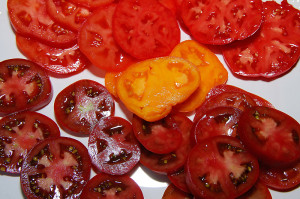
Despite significant challenges, we did get to enjoy a few tomatoes this season. Clockwise from top left, Argentina, Large Red, Black Pear and Russian Persimmon (center)
We will replace and amend our soils over the winter and spring, but to improve our potential for success next summer, we’re looking into grafting our own tomato plants in the greenhouse next spring to Fusarium and Verticulum wilt-resistant root stocks. That process though is an entire post in and of itself, so we’ll cover the details of selecting tomato root stocks, and the grafting process, in a future post.
Grafting will incur additional expense, as wilt-resistant root stock seeds are expensive, and it will require more time to do the actual grafting. However, we’re very fond of our heirloom tomatoes here at Curbstone Valley, and can’t stand the thought of another tomato season like this one, so it will be worth the extra effort if it helps to ensure a more productive growing season. Grafting, and good soils management, hopefully will improve our future yields of heirloom tomatoes in this garden.
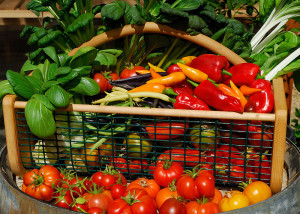
Although our peppers and tomatoes struggled this season, it wasn't all bad. Our Asian greens, kale, and beans did great!
On the upside, despite the cold weather wreaking havoc on the tomato garden, it was an excellent year for beans, spinach, kale, and Asian greens.
The great thing about gardens though is there’s always an opportunity to try again next year, but next year we’re hoping for improved weather, fewer voles, less wilt, and many more tomatoes!

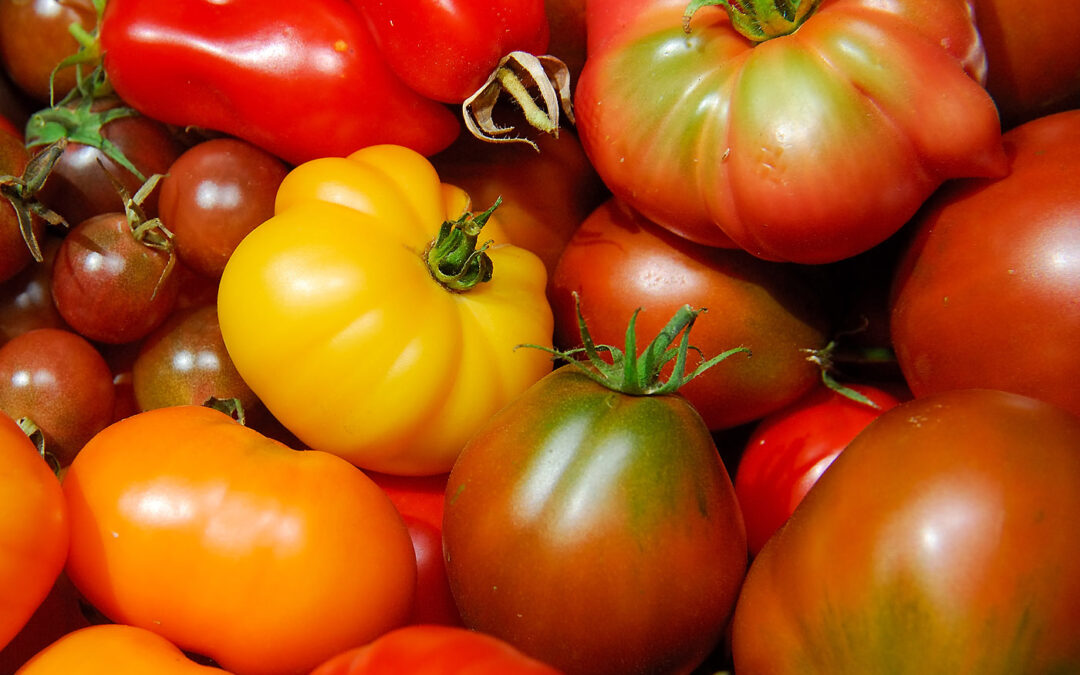
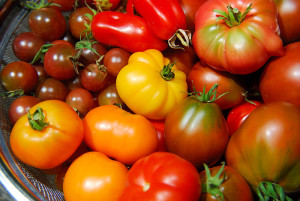
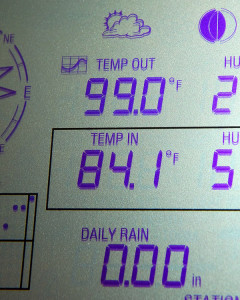
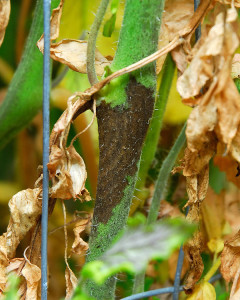
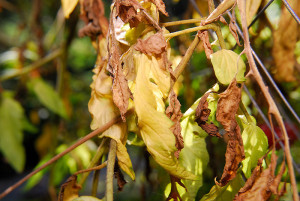
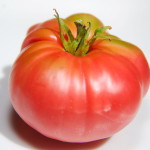
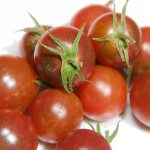
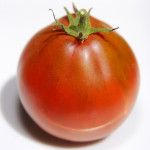

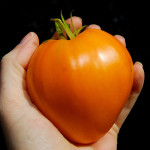
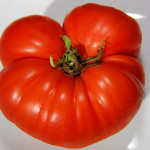

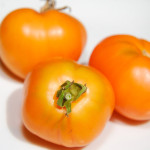
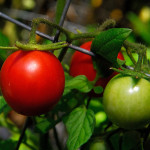
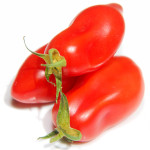

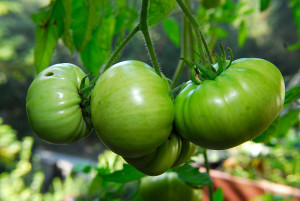







Sorry to hear it was a dismal season.
We tend to have good luck at T’s allotment garden. It’s drenched in sunshine and even though nights are cool, and some plants get yanked out because he plants too many, or disease hits here or there, I really don’t understand why we get such a huge crop.
Or why the disease does not keep spreading.
One always hears that you must rotate, and not keep planting in the same place. But his plot is small, and every year many different tomatoes are grown.
I’m mad about Japanese Black Trifele and Purple Cherokee – they are so clearly fruit rather than vegetables cuz they’re so sweet. The Purple Cherokee looks just like your Vorlon.
Here’s wishing you good production for 2012!
It really was a bizarre year for us. We’re usually like you, and have more tomatoes than we know what to do with. We’ve never had a season anything like this. That said though, the weather was strange here this year. We’re usually too hot here, not too cold in summer.
We’ve grown Cherokee Purple before. In good years it’s great, but it’s not been a reliable performer here. I think the reason Vorlon looks similar, is because Cherokee is one of Vorlon’s parents, along with Pruden’s Purple 😉
Hi,
Sorry to hear the Tomato harvest has been less than amazing; As you say though there’s always next year!
I really need to grow some heirloom varieties too, those big ones always make me so jealous 😀
I love the diversity of the heirloom varieties, in size, shape, color, and texture. They’re just so much fun to grow. Can’t plant them without thinking about who has planted them when, and where, before you. Some have been around for a very long time!
For us too it has been an odd weather year. Lots of rain and very little sunshine. Like yourselves we did okay with the greens, carrots also did well. However cucumbers and tomatoes were something of a disaster. Yields were low and tomatoes succumbed to blight in August. But again like yourselves we carry on and hope next year will be better.
I don’t usually plant Asian greens (Tatsoi, Bok Choi, Mizuna) in mid-August. I did this year, and it did fabulously well. Usually it’s too hot, and bolts too fast. If it had bolted though, at least it’s only 45 days worth of investment. When the tomatoes fail, it’s months. We started these from seed in Mid-February, so by the time Fusarium got a grip in the garden, we already had six months invested in them. We’ll take steps to minimize it next year, and I’m hoping for a much more successful harvest next season, for both of us! 🙂
Despite the slow start, your tomatoes look amazing. Your photos are so enticing I miss my tomatoes whose time has passed. Great harvest!
We did get a few good looking ones, mostly the German Orange ‘sport’ from last year’s saved seed. We planted twice as many tomatoes this year though, and had about 20% of the total harvest, and last year wasn’t great either. I should really complain though, I’d rather have fog than incessant wildfire risk in summer, but I would like a few extra tomatoes 😉
Very useful information and I shall look with interest to learn how the grafted tomato plants perform. It would be been interesting to have had more detail on flavour, for instance, marks out of 10. Black cherry sounds pretty promising but I am still on the quest for the perfect tomato taste-wise.
In my opinion there is no one perfect tomato. Different tomatoes have different complexities in flavor, and in texture. Many of the low acid yellow and orange tomatoes may be sweet, but have less robust tomato flavor, than a sultry rich black tomato. It somewhat depends on what you’re looking for. The sweetest? The smokiest? The juiciest? I’ve rarely met a homegrown tomato I didn’t like, as even the worst homegrown fruits have far superior flavor to a store bought one. However, in years such as this, where the fruits struggled to grow, both flavor, and texture are affected, so it’s difficult to evaluate them. Blondkopfchen for us this year was so bad, we’d seriously question planting it again, except we realize the fruits were a product of sick vines. As such, we’ll reserve final judgement until we try growing it again 😉
Clare your tomatoes look incredible. We were hit with wilt but the heirloom plants survived but did not yield much. I love Black Cherries but sadly we had few. I plan to plant some hardy resistant varieties with the heirlooms so we might get some tomatoes next year. The drought did not help us either as it affected our yield.
Verticulum wilt will often knock vines back, but not knock them out the same way Fusarium will. Then there’s late blight, early blight, and various other tomato maladies that can diminish your harvest too. Extremes in weather certainly don’t help, too hot, or too cold! Hopefully we can both have better yields of black cherry next year. I’m really hoping to get our tomato garden back to what it was the first couple of years we were here…but Nature is going to have to do her part with the weather 😛
Oh Clare, I am so sorry that your tomatoes did not fair well for you this year. Several years back we too had a low harvest. The last few years though have been fantastic. I grew the Russian Persimmon and San Marzano which both did fantastic. San Marzano was the most prolific roma I have grown the last few years. I really liked the flavor of both of these. I have not grown the Vorlon but will add that to my list for next year, it looks to be a beauty!
I have been battling raccoons this fall in the veggie beds. I think I finally have a solution. Albeit a temporary one.
Thanks for the great information on the tomatoes you planted. I can’t wait until March and April 2012!!
I’m looking forward to next season too! I was impressed at how many little tomatoes San Marzano produced this year, despite all the challenges in our garden this season. It’s the most popular paste variety sold at our local Farmer’s Market, and based on yield, I’m not surprised. I’m hoping next year to get a lot more, so I can make lots of sauce to store over winter! Glad you’ve managed to thwart the raccoons, but it looks like it was a lot of work to keep them at bay!
It seems many people struggled with the weather and vegetables this year. In our region after a cold wet start the tomatoes formed but refused to ripen. Then a warm humid mass took over and everything was lost to blight. Rust was also an issue with hollyhocks in my garden. I’ll be interested to see how your grafting adventure goes. I considered removing the soil in my beds as well but the blight really moved everywhere. Even stray tomatoes that grew from compost in the flower bed became infested. I can’t remove the soil from every single bed so I will be adding a new layer of compost overtop next year and take my chances I suppose.
The weather was extreme, to one end of the spectrum or the other, for a lot of gardeners this year. Those just inland from us did fairly well with tomatoes this year, but a lot of us along the coast really struggled to produce good crops this year. On the upside, the cool weather did enable us to get our retaining wall built, and the greenhouse put up, so at least gardener productivity increased, even if garden productivity did not 😉
I know a lot of people who struggled with their tomatoes this year. My own were all gone by the end of July, succumbed to heat stress, drought, and disease. Parks Whopper produced the best, hardly an heirloom! Unfortunately, over the years I have had little success with heirlooms. I look forward to seeing if your grafting is successful!
I’m excited to try grafting for tomatoes. I love heirlooms, but as they haven’t been selected for the same level of disease resistance as hybrid varieties, they can be unpredictable in the garden. If the disease resistant root stocks do their job, they should help our tomatoes perform better. However, I’m probably going to have to start quite a few extra seedlings in spring, as I’m sure it will take some practice grafting the heirloom scions to the root stock 😉
Clare, your tomatos look amazing even if it was not a good year for you. It is comforting to see that experienced people like yourselves also have problems though – I always feel like such a rookie when my veg develop “issues” and blame myself. I see now from your post that what my tomatoes had was probably wilt – it looked exactly the same.
PS: Thank you for the caring, lovely message you left on my blog. It really meant a lot to me.
Even the most experienced commercial farmers suffer from crop failures, or poor yields. Weather and pests aren’t always predictable. Growing heirloom varieties organically certainly comes with its own elements of risk, as many aren’t resistant to some of the common bacterial and fungal wilts, or nematode infections. Our own gardens are fairly new, and as yet are still acquiring that balance in the garden. It takes time to build strong soils, and for the predator-prey balance to sort itself out. However, I’d rather take the occasional losses at this stage, than spray the garden with toxins, and synthetic fertilizers, just to ensure a harvest.
Clare, it was again not the best gardening weather this year for our tomatoes either. I am so sorry about the difficulty you had with yours; thankfully, we did not have the same experience, but our yield was poor. And had it not been for the over-planting of Cherokee Purple, we might not have had many tomatoes at all. Our San Marzano did not grow as large as they did last year, and compared to last year, we have very few green tomatoes remaining on the vines. Time to pick them all and make some salsa. 😉 Have a wonderful week ahead.
This season was unusually short, for many of us I think. I shouldn’t complain though, at least we had a few, but it’s just so disappointing when traditionally they’ve done very well. Hopefully next season will be warmer for both of us, and tomatoes will do better.
Clare, I just finished dinner and seeing your tomatoes has made me hungry all over again! Truthfully, I am longing for a delicious tomato warm and fresh from the garden or maybe one of those Russians on a pizza! Sigh, alas none here, too shady! The rodents ate all my ripe cherry tomatoes~I will try them again next year, but, will keep them netted. They are really lovely looking tomatoes gail
Goodness Gail, I never would have imagined your garden too shady for tomatoes. You have my sympathy on the rodent front though. I hope the netting successfully thwarts them for you next year. I personally consider it high treason when something eats the tomatoes before we have a chance too! 😉
How lovely, Clare. Each of your posts is a work of art and so informative. Have no clue how you do it all!